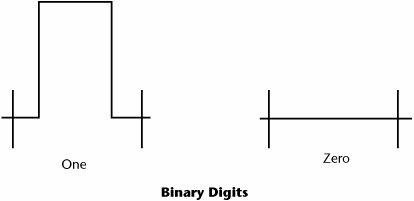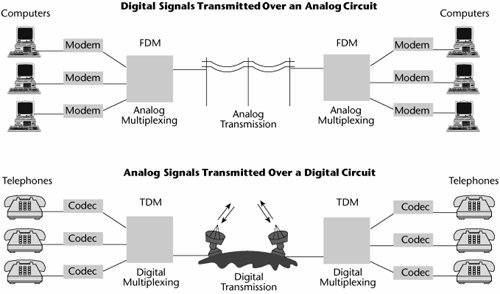Analog and Digital Transmission
There are a number of differences between analog and digital transmission, and it is important to understand how conversions between analog and digital occur. Let's look first at the older form of transmission, analog.
Analog Transmission
An analog waveform (or signal) is characterized by being continuously variable along amplitude and frequency. In the case of telephony, for instance, when you speak into a handset, the air pressure changes around your mouth. Those changes in air pressure fall onto the handset, where they are amplified and then converted into current, or voltage fluctuations. Those fluctuations in current are an analog of the actual voice patternhence the use of the term analog to describe these signals (see Figure 1.9).
Figure 1.9. Analog transmission

When it comes to an analog circuitwhat we also refer to as a voice-grade linewe need to define the frequency band in which it operates. The human voice, for example, can typically generate frequencies from 100Hz to 10,000Hz, for a bandwidth of 9,900Hz. But the ear does not require a vast range of frequencies to elicit meaning from ordinary speech; the majority of sounds we make that constitute intelligible speech fall between 250Hz and 3,400Hz. Therefore, the phone company typically allotted a total bandwidth of 4,000Hz for voice transmission. Remember that the total frequency spectrum of twisted-pair is 1MHz. To provision a voice-grade analog circuit, bandwidth-limiting filters are put on that circuit to filter out all frequencies above 4,000Hz. That's why analog circuits can conduct only fairly low-speed data communications. The maximum data rate over an analog facility is 33.6Kbps when there are analog loops at either end.
Analog facilities have limited bandwidth, which means they cannot support high-speed data. Another characteristic of analog is that noise is accumulated as the signal traverses the network. As the signal moves across the distance, it loses power and becomes impaired by factors such as moisture in the cable, dirt on a contact, and critters chewing on the cable somewhere in the network. By the time the signal arrives at the amplifier, it is not only attenuated, it is also impaired and noisy. One of the problems with a basic amplifier is that it is a dumb device. It knows only how to add power, so it takes a weak and impaired signal, adds power to it, and brings it back up to its original power level. But along with an increased signal, the amplifier passes along an increased noise level and adds its own internal noise. So in an analog network, each time a signal goes through an amplifier, it accumulates noise. After you mix together coffee and cream, you can no longer separate them. The same concept applies in analog networks: After you mix the signal and the noise, you can no longer separate the two, and, as a result, you end up with a lot of noise and very high error rates.
Digital Transmission
Digital transmission is quite different from analog transmission. For one thing, the signal is much simpler. Rather than being a continuously variable waveform, it is a series of discrete pulses, representing one bits and zero bits (see Figure 1.10). Each computer uses a coding scheme (called a collating sequence) that defines what combinations of ones and zeros constitute all the characters in a character set (e.g., lowercase letters, uppercase letters, punctuation marks, digits, keyboard control functions).
Figure 1.10. Digital transmission

How the ones and zeros are physically carried through the network depends on whether the network is electrical or optical. In electrical networks, one bits are represented as high voltage, and zero bits are represented as null, or low voltage. In optical networks, one bits are represented by the presence of light, and zero bits are represented by the absence of light. The ones and zerosthe on/off conditionsare carried through the network, and the receiving device repackages the ones and zeros to determine what character is being represented.
Because a digital signal is easier to reproduce than an analog signal, we can treat it with a little less care in the network. Rather than use dumb amplifiers, digital networks use regenerative repeaters, also referred to as signal regenerators. As a strong, clean, digital pulse travels over a distance, it loses power, similar to an analog signal. The digital pulse, like an analog signal, is eroded by impairments in the network. But the weakened and impaired signal enters the regenerative repeater, where the repeater examines the signal to determine what was supposed to be a one and what was supposed to be a zero. The repeater regenerates a new signal to pass on to the next point in the network, in essence eliminating noise and thus vastly improving the error rate.
Analog Versus Digital Transmission
Table 1.1 summarizes the characteristics of analog and digital networks.
|
Feature |
Analog Characteristics |
Digital Characteristics |
|---|---|---|
|
Signal |
Continuously variable, in both amplitude and frequency |
Discrete signal, represented as either changes in voltage or changes in light levels |
|
Capacity measurement |
Hz (e.g., a telephone channel is 4KHz) |
Bits per second (e.g., a T-1 line carries 1.544Mbps, and an E-1 line transports 2.048Mbps) |
|
Bandwidth |
Low bandwidth (4KHz), which means low data transmission rates (up to 33.6Kbps) because of limited channel bandwidth |
High bandwidth that can support high-speed data applications that involve video and multimedia |
|
Network capacity |
Low; one conversation per telephone channel |
High; multiplexers enable multiple conversations to share a communications channel and hence to achieve greater transmission efficiencies |
|
Network manageability |
Poor; a lot of labor is needed for network maintenance and control because dumb analog devices do not provide management information streams that allow the device to be remotely managed |
Good; smart devices produce alerts, alarms, traffic statistics, and performance measurements, and technicians at a network control center (NCC) or network operations center (NOC) can remotely monitor and manage the various network elements |
|
Signal structure |
High; the signal contains a wide range of frequencies and amplitudes |
Low; only two discrete signalsthe one and the zeroneed to be transmitted |
|
Security |
Poor; when you tap into an analog circuit, you hear the voice stream in its native form, and it is difficult to detect an intrusion |
Good; encryption can be used |
|
Error rates |
High; 105 bits (i.e., 1 in 100,000 bits) is guaranteed to have an error |
Low; with twisted-pair, 10-7 bits (i.e., 1 in 10 million bits) has an error; with satellite, 109 bits (i.e., 1 in 1 billion bits) has an error; and with fiber, 1011 bits (i.e., 1 in 100 billion bits) to 1013 bits (i.e., 1 in 10 trillion bits) has an error |
Conversion: Codecs and Modems
Today we don't have all-digital or all-analog networks; we have a mix of the two. Therefore, at various points in a network, it is necessary to convert between the two signal types. The devices that handle these conversions are codecs and modems (see Figure 1.11).
Figure 1.11. Codecs and modems

A codec (which is a contraction of coderdecoder) converts analog signals into digital signals. There are different codecs for different purposes. For the PSTN, for example, there are codecs that minimize the number of bits per second required to carry voice digitally through the PSTN. In cellular networks, because of the constraints and available spectrum, a codec needs to compress the voice further to get the most efficient use of the spectrum. Codecs applied to video communication also require very specific compression techniques to move those high-bandwidth signals over what may be somewhat limited channels today.
A modem (which is a contraction of the terms modulate and demodulate) is used to infuse digital data onto transmission facilities and vice versa. Some modems are designed specifically to work with analog voice-grade lines. There are also modems designed to work specifically with digital facilities (e.g., ISDN modems, ADSL modems). A modem manipulates the variables of the electromagnetic wave to differentiate between the ones and zeros.
Although it is possible to convert between analog and digital networks, in general, conversions are a weak link in a network. A conversion is a point at which network troubles can occur, an opportunity for errors and distortions to be introduced. Therefore, ideally, we want to move toward an end-to-end digital and end-to-end optical environment. This means that nowhere between the transmitter and the receiver do signal conversions need to be done.
Part I: Communications Fundamentals
Telecommunications Technology Fundamentals
- Telecommunications Technology Fundamentals
- Transmission Lines
- Types of Network Connections
- The Electromagnetic Spectrum and Bandwidth
- Analog and Digital Transmission
- Multiplexing
- Political and Regulatory Forces in Telecommunications
Traditional Transmission Media
Establishing Communications Channels
- Establishing Communications Channels
- Establishing Connections: Networking Modes and Switching Modes
- The PSTN Versus the Internet
The PSTN
- The PSTN
- The PSTN Infrastructure
- The Transport Network Infrastructure
- Signaling Systems
- Intelligent Networks
- SS7 and Next-Generation Networks
Part II: Data Networking and the Internet
Data Communications Basics
- Data Communications Basics
- The Evolution of Data Communications
- Data Flow
- The OSI Reference Model and the TCP/IP Reference Model
Local Area Networking
Wide Area Networking
The Internet and IP Infrastructures
- The Internet and IP Infrastructures
- Internet Basics
- Internet Addressing and Address Resolution
- The Organization of the Internet
- IP QoS
- Whats Next on the Internet
Part III: The New Generation of Networks
IP Services
Next-Generation Networks
- Next-Generation Networks
- The Broadband Evolution
- Multimedia Networking Requirements
- The Broadband Infrastructure
- Next-Generation Networks and Convergence
- The Next-Generation Network Infrastructure
Optical Networking
- Optical Networking
- Optical Networking Today and Tomorrow
- End-to-End Optical Networking
- The Optical Edge
- The Optical Core: Overlay Versus Peer-to-Peer Networking Models
- The IP+Optical Control Plane
- The Migration to Optical Networking
Broadband Access Alternatives
- Broadband Access Alternatives
- Drivers of Broadband Access
- DSL Technology
- Cable TV Networks
- Fiber Solutions
- Wireless Broadband
- Broadband PLT
- HANs
Part IV: Wireless Communications
Wireless Communications Basics
- Wireless Communications Basics
- A Brief History of Wireless Telecommunications
- Wireless Communications Regulations Issues
- Wireless Impairments
- Antennas
- Wireless Bandwidth
- Wireless Signal Modulation
- Spectrum Utilization
Wireless WANs
- Wireless WANs
- 1G: Analog Transmission
- 2G: Digital Cellular Radio
- 5G: Enhanced Data Services
- 3G: Moving Toward Broadband Wireless
- Beyond 3G
- 4G: Wireless Broadband
- 5G: Intelligent Technologies
WMANs, WLANs, and WPANs
Emerging Wireless Applications
- Emerging Wireless Applications
- The Handset Revolution
- Mobile IP
- The IP Multimedia Subsystem
- Mobile Gaming
- Mobile Video
- Mobile TV
- Mobile Content
Glossary
EAN: 2147483647
Pages: 160
